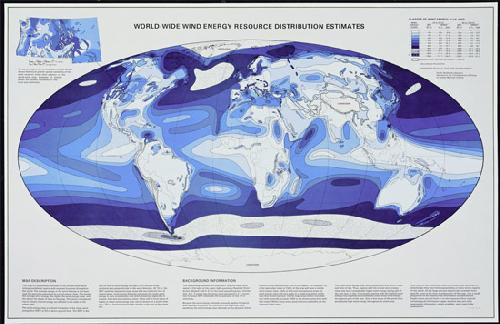A windmill in Soenderho, Fanoe, Denmark. The whole mill can rotate. It has a fantail to keep it pointed in the direction of the prevailing wind, thus maximising the volume of air passing it.
Wind is the movement of air, and like anything that moves, it has energy.[1] Since ancient times this energy has been tapped by windmills, which use the wind to pump water or to turn a mill to grind corn.
Nowadays the energy of the wind is harnessed for the generation of electricity. It is an attractive source of power because it is sustainable, has a low environmental impact and is cheap relative to other renewable energy sources. It is estimated that by 2016 onshore wind electricity will cost the same as that generated by burning coal, with offshore costing up to one-and-a-half times more.[2] There is also plenty of it: the total wind energy that could theoretically be used on land and in shallow waters is about five times current worldwide energy consumption.[3] In 2010 it supplied 2.5% of the world's electricity.[4]
In the remainder of this slideshow we will examine how wind turbines work and the issues they raise.
Wind energy ultimately comes from the Sun. The Sun heats the surface of the earth unevenly, creating differences in temperature in the air above it. For example: water and land absorb the energy at different rates; different latitudes receive different amounts of Sun; and the sunlight also depends on the time of day. Hot air rises, causing cooler to come in and replace it, generating wind.
Note that air has kinetic energy because it has a mass and it moves. In the next slide we will quantify this energy.
In 2016 it is estimated that onshore wind electricity will cost 100 US dollars per megawatthour, the same price as coal. Wind generated offshore will cost more at 250 US dollars per megawatthour. These figure comes from the Annual Energy Outlook 2011 from the US Department of Energy. It is a prediction for a plant to be installed in 2016, taking into account all expenses, including construction and maintenance. See also Wikipedia:Cost of electricity by source for other studies. They do tend to vary widely.
The reason for the variation in pricing is that the price depends strongly on how windy the site is where the turbine is situated. The biggest part of the cost of wind energy is the initial capital cost of the turbine. How much the energy subsequently costs is then determined by how much it produces over its lifetime. The energy delivered by the turbine over time goes with the cubic power of the wind speed, so a small increase in wind speed leads to a dramatic drop in price.

World wind distribution.
This figure is taken from the study Evaluation of global wind power by Cristina L. Archer and Mark Z. Jacobson in the Journal of Geophysical Research - Atmospheres (2005).
This figure is also backed up by, for example, the paper Global potential for wind-generated electricity (PDF) by Xi Lua, Michael B. McElroya, and Juha Kiviluomac in PNAS (2009).
In 2010 worldwide wind production was 430 TWh, which is about 2.5% of worldwide electricity usage. In some countries the proportion is much higher, with wind providing 21% of electricity in Denmark and 18% in Portugal, for example. These figures come from the World Wind Energy Report 2010 (PDF) from the World Wind Energy Association.
Author: Tom Brown
Copyright: public domain
Date last modified: 11th Oct 2011
Peer-review status: Not yet peer-reviewed
http://commons.wikimedia.org/wiki/File:DK_Fanoe_Windmill01.JPG: By Cnyborg (Own work) [GFDL (www.gnu.org/copyleft/fdl.html), CC-BY-SA-3.0 (www.creativecommons.org/licenses/by-sa/3.0/) or CC-BY-SA-2.5 (www.creativecommons.org/licenses/by-sa/2.5)], via Wikimedia Commons
http://www.polarhusky.com/logistics/maps-and-route/data/wind-energy/: copyright unknown